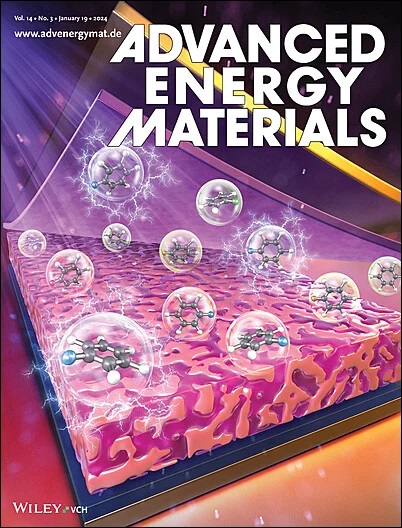Dimeric Acceptors Using Different Central Linkers to Manipulate Electronic and Morphological Properties
IF 24.4
1区 材料科学
Q1 CHEMISTRY, PHYSICAL
引用次数: 0
Abstract
Dimerized acceptors show promise in combining the high performance of small‐molecule non‐fullerene acceptors (NFAs) with the excellent stability of polymer acceptors. The central linking units that connect two acceptor molecules together have a profound impact on dimeric acceptor properties and structure‐performance relationships in blended thin films. It is seen that different linkers significantly affect the electronic properties and morphology in blended thin film. The electron‐donating linker elevates the absorption coefficient, affords a lower bandgap, and reduces energy loss, and thus better photovoltaic device performance. Better fibrillar morphology can be obtained. The best material DY‐EDOT‐based device shows a power conversion efficiency (PCE) of 18.21%, an open‐circuit voltage (求助全文
约1分钟内获得全文
求助全文
来源期刊

Advanced Energy Materials
CHEMISTRY, PHYSICAL-ENERGY & FUELS
CiteScore
41.90
自引率
4.00%
发文量
889
审稿时长
1.4 months
期刊介绍:
Established in 2011, Advanced Energy Materials is an international, interdisciplinary, English-language journal that focuses on materials used in energy harvesting, conversion, and storage. It is regarded as a top-quality journal alongside Advanced Materials, Advanced Functional Materials, and Small.
With a 2022 Impact Factor of 27.8, Advanced Energy Materials is considered a prime source for the best energy-related research. The journal covers a wide range of topics in energy-related research, including organic and inorganic photovoltaics, batteries and supercapacitors, fuel cells, hydrogen generation and storage, thermoelectrics, water splitting and photocatalysis, solar fuels and thermosolar power, magnetocalorics, and piezoelectronics.
The readership of Advanced Energy Materials includes materials scientists, chemists, physicists, and engineers in both academia and industry. The journal is indexed in various databases and collections, such as Advanced Technologies & Aerospace Database, FIZ Karlsruhe, INSPEC (IET), Science Citation Index Expanded, Technology Collection, and Web of Science, among others.
 求助内容:
求助内容: 应助结果提醒方式:
应助结果提醒方式:


